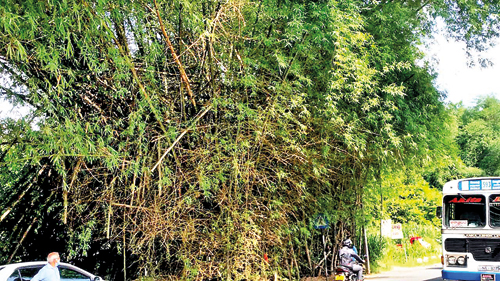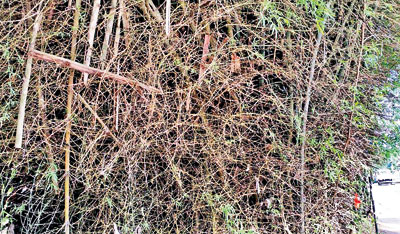A thorny solution to Human – Elephant conflict

Katu una: Planted along Pinga Oya, Katugastota to prevent river bank erosion
The national elephant population has been recently estimated to be 7379. While they mostly occupy protected areas (PAs) covering only about 12.5 percent of the total land area, a considerable number of elephants, estimated to be about 20 percent, roam outside PAs. It is important to note that elephants do not recognize human-designated boundaries, but freely migrate in their home ranges mainly guided by seasonal influences and their needs of food and water. The financial burden and allocation of human resources by the government to minimize elephants invading human habitations and agricultural landscapes are enormous. Clearly the idea of restricting elephants in PAs will not be possible.
Thorny bamboo fence (‘Katu-una Ali-weta’)
A botanical solution to prevent wild elephants invading human habitations and farm lands is proposed here which can also be called a live fence or biological fence using native and locally occurring exotic plants that are potential deterrents against elephant movement. The most prominent species focused on here is ‘Katu-una’ or Thorny bamboo, (Bambusa bambos). This species occurs naturally in Sri Lanka, as well as in southeastern Asia, and is now widely introduced and cultivated throughout the tropics.
In Sri Lanka, ‘Katu-una’ generally occurs in forested habitats in hills areas in the Intermediate Zone or in areas that are influenced by intermediate climatic conditions, e.g., Ritigala, Dambulla, Minneriya, Wasgamuwa and Victoria–Randenigala–Rantembe (VRR) Sanctuary etc.
‘Katu-una’ commonly grows to a height of about 10-15 metres and sometimes even up to 30 metres. The stems (culms) are erect and closely placed forming dense clumps or colonies. Each stem produces, at all its nodes, long, wiry, spiny branches which form an interlacing tangle of spiny armour acting as an impenetrable multilayered live fence. Therefore, a suitably spaced ‘Katu-una’ fence is expected to provide an effective barrier against elephant movement.
Previous uses of ‘Katu-una’ in Sri Lanka
The cultivation of ‘Katu-una’ recorded in Sri Lanka, although not to restrain elephants, was possibly four to five decades ago when it was cultivated in selected plots in Minneriya ‘Wildlife Reserve’ (National Park) for providing long fibre material for the Valachchenai Paper Factory. However, it is stated that the factory never used the bamboo, but it has been spreading in the reserve without serving any purpose except for keeping away the elephants. Therefore, the park authorities later had to remove ‘Katu-una’ in the park. Instances of elephants eating ‘Katu-una’ have been observed in the Minneriya National Park.

A bamboo colony forming an interlacing tangle of spiny branches. Pix courtesy Dr. Nimal Dissanayake
Thorny bamboo as elephant fences in other countries
Although ‘Katu-una’ has not yet been used in Sri Lanka as a solution for HEC, there are records of its use in some other Asian countries. Through the WWF-India initiative, fencing with Thorny bamboo is carried out to protect tea estates and associated households of the workers in Assam.
In Thailand, the Department of National Parks, Wildlife and Plant Conservation (DNP) has also employed the method of fencing with Thorny bamboo (‘Shazam’) to prevent elephants in the Khao Yai National Park in the Central Thailand from invading areas outside the park. Apparently, this new project commenced only a few years ago. If this exercise is proven successful, the method is expected to be used in the other forest areas under the DNP’s administration. However, the DNP presumes that it will take at least five years before the fencing becomes effective.
Propagation and cultivation
Bamboo can be propagated by tissue culture, nodal segments, rhizomes and seeds. Of these the best for large-scale propagation would be the tissue culture and nodal segment methods.
Recommendation
It is evident that the Thorny bamboo fence will provide a natural, efficient, cost-effective, and permanent barrier against invading elephants. Although the initial cost and labour involved in establishing a bamboo fence will be considerable and the time required for the fence to be functional will be five years or more, once established, the ‘Katu-una Ali-weta’ requires only minimum maintenance and supervision and hence is relatively more sustainable.
Therefore, the immediate attention of the authorities of the wildlife sector is drawn to this matter. Pilot projects in areas that are seriously inflicted with the HEC will require prior attention, first in supplementing existing electric fences targeting step-wise replacement of the latter with bamboo fences. If proven successful, the process is expected to be expanded in other sensitive areas. Community participation including schoolchildren will be mandatory in relevant areas in order to endow ownership and responsibility to the main beneficiaries, namely the farming communities and general public.
As the HEC involves two intelligent species, a successful and sustainable solution that guarantees complete safety to people and property, while securing conservation of elephants has not yet evolved in any country. Therefore, the total dependence on one technique, such as electric fences to contain the HEC will not be prudent and the need of a concerted approach involving different methods seems strategically important. It is further proposed that the wildlife conservation authorities will bring this proposal to the attention of officials of the relevant government sectors, HEC experts, nature conservationists and representatives of farmer communities etc.
(The writer is attached to EML Consultants (Pvt) Ltd, and is Chairman, National Experts Committee on Biodiversity Conservation, Ministry of Environment, former Director, Plant Genetic Conservation Centre, Department of Agriculture and former Curator of the National Herbarium, National Botanical Gardens)



